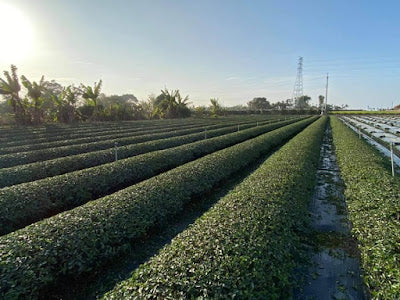

· By Jen Biro
The Delicacy of Oolong
For the consummate tea drinker, oolong teas hold a special place in their heart. While there is great attention given to the processing of all teas, oolongs require the hand of a skilled tea master to fully capture the spectrum of flavors oolong holds. The beauty of oolong, aside from the sweet- savory flavor, is that it falls somewhere between a black and green tea. So, when the afternoon sleepies start to come around and you need a little pick me up that won't keep you up all night, turn oolong. The caffeine content will be lower than black tea and it will give you the oh so needed boost to get you through the rest of the day.
Determining when a tea has reached the classification of oolong is by the process of oxidation. Black teas are left to fully oxidize, giving the leaves their dark color and malty aroma they are known for. Green teas, on the other hand, are barely left to oxidize at all, so the leaves retain a small of green leafy color. How long an oolong will go through the oxidation process will depend on the production style of the tea master. This is the leading reason why oolong tea comes in such varied selections. Some lean closer to fresh green teas (less oxidized) and others a malty black tea (more oxidized). You may have noticed in your adventures in tea, that tea leaves tend to come in tight balls or thin strands. The shape which the oolong leaves take on will alter the color, aroma, and the final flavor the tea leaves take on.
Camellia sinensis. This is the tea plant from which all tea springs forth. Black, green, white, oolong, you name it, camellia sinensis is the foundation for all of these teas. The determining factors for what end up in your cup comes down to the variety of cultivar of the tea plant, the terroir of the plant (the characteristics of geography, climate, and culture) and how the tea leaves are processed after they are hand picked. The origins of oolong can be traced back to the mountainous regions of China and Taiwan. In China, oolong production in the Fujian Province is done in two concentrated regions; in the Wuyi Mountains and Anxi County. Oolongs in this area are grown high in the mountains where the air is cool and sweet with rocky terrain. This environment lends a richer, deeper flavor to the oolong. In Taiwan, the Taitung and Hualien Counties along the eastern region of the country are responsible for the more delicate and greener oolongs. Here, oolongs are grown in misty covered mountains or bamboo-forested foothills. Oolongs are harvested either in the early spring for a flowery herbaceous flavor or in the winter where they are roasted for an earthy, woodsy flavor.
The nature of oolong is one that changes subtly depending on the region the tea plant is from and the way in which the tea master chooses to develop the oxidation process. An oolong cup profile can range from light to full bodied, floral to grassy, and sweet to toasty. The color of the tea leaves can vary between mossy green to golden brown to an earthy brown. Many oolong connoisseurs will note the similarities of tasting a fine oolong to the differences between a fine wine. As all of the above content states, oolong is a lot like wine in that both originate from a single source, rely heavily on terroir, along with the tea master or wine maker who will ensure each offering is beyond reproach.
Drinking fine teas is a small luxury that, thankfully, just about anyone can afford. If you are a long time tea drinker and need a bit of a refresher or someone new to the world of tea, please visit our brewing instructions for tea. Vail Mountain Coffee & Tea Co. only purchases the creme de la creme of loose leaf teas because life is too short for anything else!